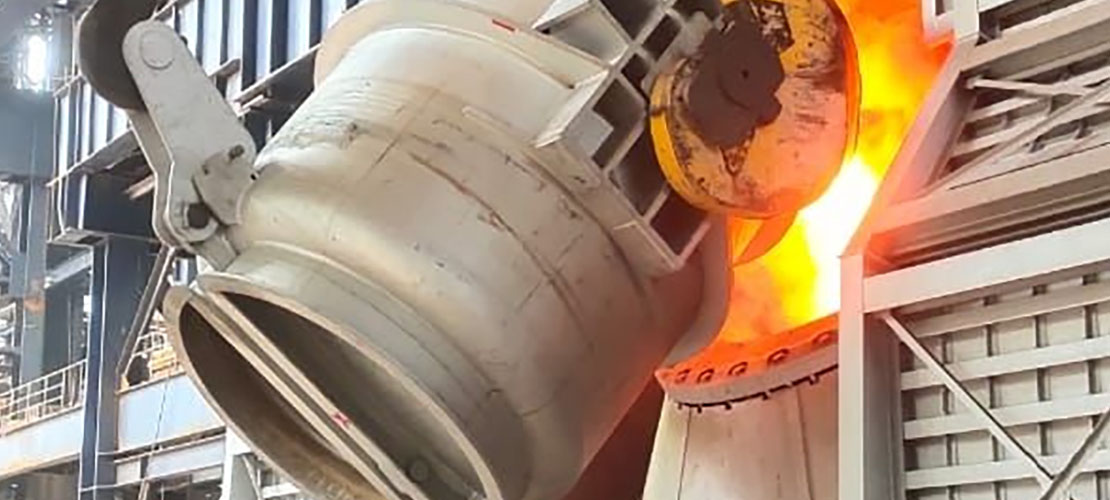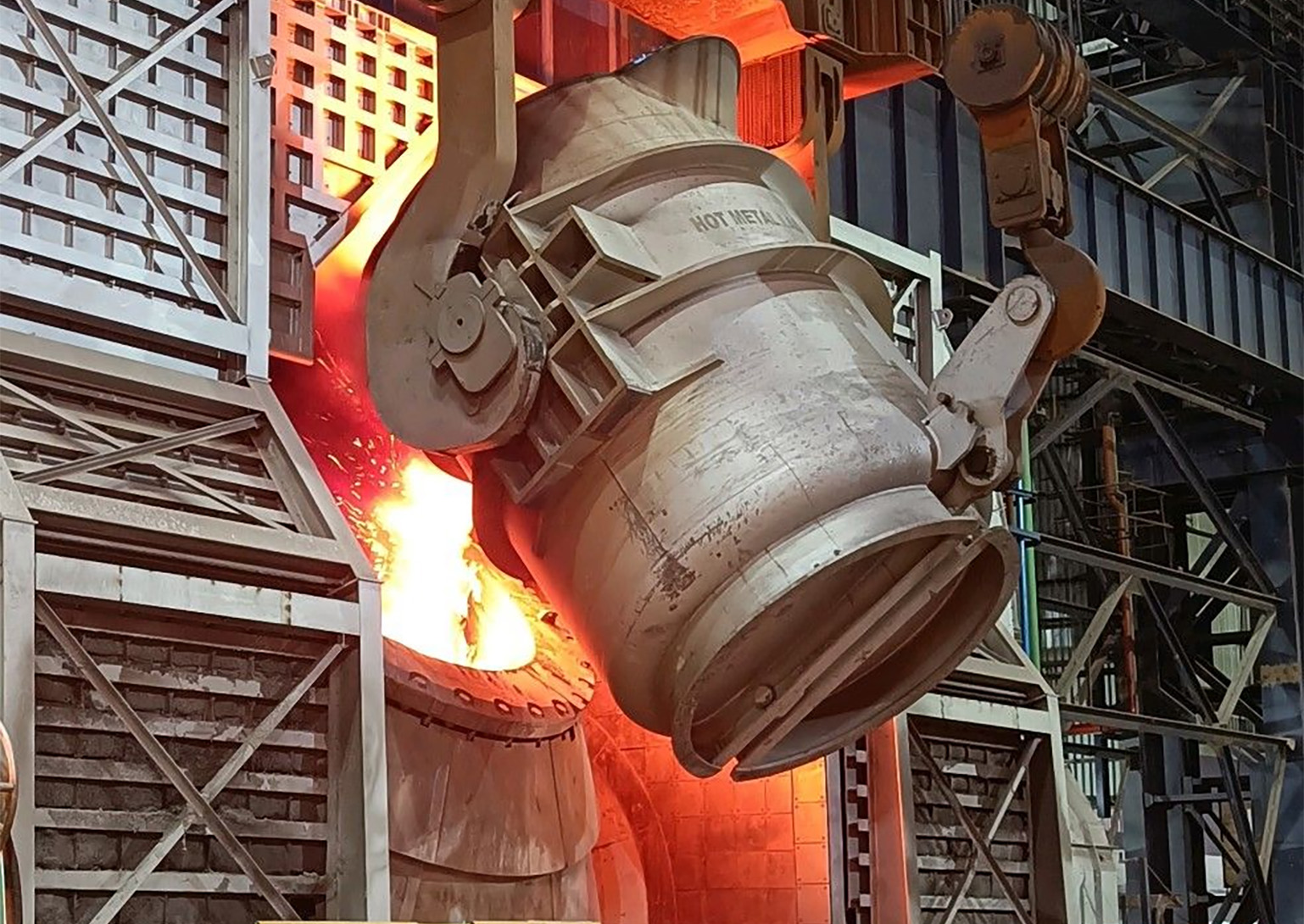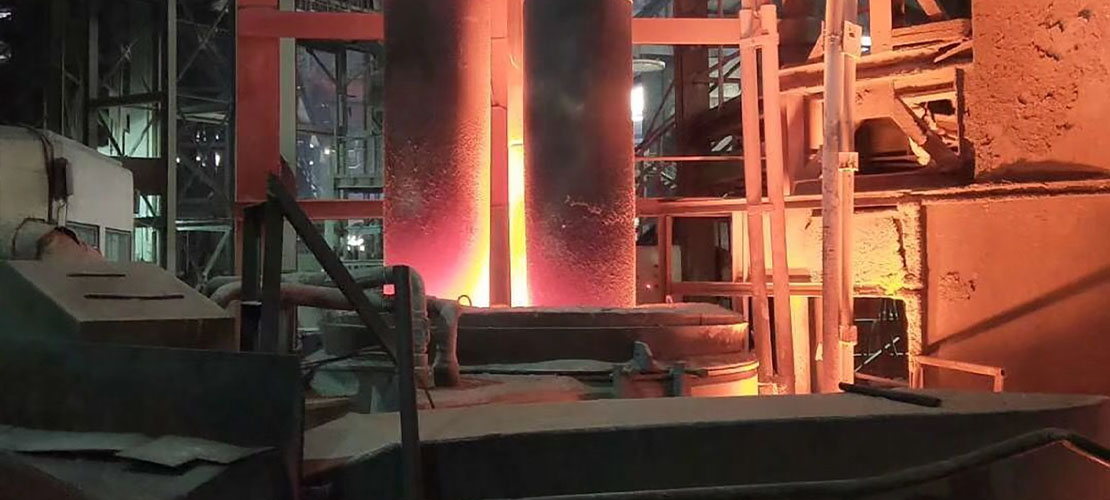Jun. 22, 2025

The core task of the converter plant is to further refine the pig iron produced by the blast furnace into high-quality molten steel, and then cast it into standard ingots for efficient rolling in various rolling mills. The purpose of smelting is to remove carbon and other impurity elements (such as silicon and manganese) in the pig iron by oxidation, so as to create high-quality steel that surpasses iron in physical, chemical and mechanical properties.
Before the molten iron enters the converter, a series of pretreatments are carried out to ensure its purity and efficient utilization. These treatments are aimed at removing harmful elements such as sulfur (S) and phosphorus (P) in the molten iron, while recovering rare elements such as niobium (Nb) and vanadium (V) as much as possible. Among them, the injection method is a commonly used technology. Nitrogen is used to blow granular magnesium into the molten iron, which not only removes impurities, but also effectively stirs the molten iron to prepare for subsequent refining steps. This treatment method can be carried out in the mixing car or in the ladle.
(2) Application of KR method (mechanical stirring method)
The KR method, also known as mechanical stirring method, forms a conical vortex in the central area of the molten iron by sinking a cross-shaped impeller stirring head into the molten iron and rotating it. This process promotes the full mixing and reaction between the desulfurizer and the molten iron, thereby improving the desulfurization efficiency.
Figure 1 shows the rotation of the cross-shaped impeller stirring head in the molten iron during the KR desulfurization process. Through this mechanical stirring method, the conical vortex formed in the central area of the molten iron effectively promotes the mixing and reaction of the desulfurizer and the molten iron, thereby improving the desulfurization efficiency.

(1) Molten iron: Molten iron is the main raw material for converter steelmaking, and its amount usually accounts for 70-100% of the metal material charge.
(2) Scrap steel: Scrap steel is used as an auxiliary raw material in converter steelmaking, and its dosage can be controlled between 0 and 30%.
(3) Ferroalloys: Ferroalloys play an important role in deoxidation and composition adjustment in the steelmaking process. Common deoxidizers include ferromanganese, ferrosilicon, etc., while alloy materials include ferromanganese, ferrosilicon, etc., which are used to adjust the composition of molten steel.
(1) Lime: Lime is the basic slag-making material for converter steelmaking. It can remove phosphorus and sulfur through slag making, protect the furnace lining and serve as a coolant.
(2) Fluorite: Fluorite is mainly used as a flux in the converter to promote the formation and flow of slag.
(3) Dolomite: Dolomite can partially replace lime, reduce the amount of lime used, and help early slag and final slag thickening, thereby extending the life of the furnace lining.
(4) Oxidizers: Commonly used oxidants in converter steelmaking include oxygen, iron ore and iron oxide scale, which participate in the oxidation reaction of molten steel.
(5) Coolant: In order to control the furnace temperature and reaction process, scrap steel, iron ore, iron oxide, lime and dolomite are used as coolants in converter steelmaking.
(6) Carbon enhancer: Carbon enhancer such as carbon powder and carbon wire is used to increase the carbon content in steel to meet specific carbon content requirements.
The core equipment of oxygen top-blown converter includes furnace body, tilting device and oxygen supply equipment. These equipment work together to complete various process flows of converter steelmaking.
Furnace body: The outer layer of the furnace body is the furnace shell, which bears the entire weight of refractory materials, molten steel and slag, and maintains the fixed shape of the furnace. The inside of the furnace shell is filled with a certain thickness of alkaline refractory materials.
Tilt equipment: This equipment includes motor brake device, deceleration device and support bearing. Its function is to enable the furnace body to tilt, so as to meet the process requirements of adding molten iron, adding scrap steel, sampling, tapping and pouring slag, and ensure that the furnace body can rotate 360° forward and reverse.
Oxygen supply equipment: mainly includes oxygen gun and oxygen supply system. Oxygen gun, also known as spray gun or oxygen spray pipe, is responsible for blowing high-pressure oxygen into the molten pool.
[Oxygen top-blown converter steelmaking method] is an oxygen gun that extends vertically directly through the furnace mouth, blowing high-pressure oxygen into the molten pool to oxidize and remove carbon, silicon, manganese, phosphorus and other elements in the molten iron. This method uses the physical heat of molten iron and the chemical heat generated by element oxidation to achieve the high temperature required for smelting without an external heat source.
[Top and bottom composite blowing] is based on top blowing, and blows in an appropriate amount of gas from the bottom at the same time to enhance the stirring of the metal molten pool and slag, and control the partial pressure of CO in the gas phase in the molten pool. This not only overcomes the lack of stirring capacity of the top-blown oxygen flow, but also makes the reaction in the furnace closer to equilibrium, reduces iron loss, and retains the advantage of the top-blowing method that it is easy to control the slag-making process.

External furnace refining is to move part of the tasks in the steelmaking furnace to the ladle or other special containers to complete, thereby dividing the traditional steelmaking process into two steps: primary refining and refining. Through out-of-furnace refining, the molten steel can be deeply decarburized, desulfurized, deoxidized, degassed, composition adjusted and temperature homogenized under vacuum, inert atmosphere or controlled atmosphere, while removing inclusions and changing their morphology and composition.
Ladle argon blowing is to blow a certain amount and pressure of argon into the molten steel through the air-permeable bricks at the bottom of the ladle to remove harmful gases and non-metallic inclusions, and to even out the temperature and composition of the molten steel and improve its fluidity. When the RH method is used to treat the molten steel, the riser and downcomer at the lower end of the vacuum chamber are first inserted into the molten steel in the ladle, and the molten steel is raised to the pressure difference height in the vacuum chamber by vacuuming for degassing.
At this time, argon is blown into the riser. Since the molten steel contains argon bubbles, its density decreases, causing the molten steel to continue to rise. At the same time, the liquid level in the vacuum chamber gradually rises. In contrast, the density of the molten steel in the downcomer is large, so it descends and flows back to the ladle. Through this continuous cycle, the molten steel continuously enters the vacuum chamber and is efficiently degassed under vacuum. In addition, various alloys can be added to the vacuum chamber according to the different needs of steel grades.

The LF method uses graphite electrodes for heating, and the arc is buried in the slag layer on the surface of the molten steel. The molten steel is refined by using synthetic slag making materials, blowing argon at the bottom of the ladle, and maintaining a strong reducing atmosphere in the ladle .
Argon blowing treatment of ladle, also known as argon blowing treatment of molten steel, is a simple off-furnace refining method for degassing molten steel and removing non-metallic inclusions. This method has simple process, cheap equipment and significant refining effect.
Open the fourth electronic control valve on the second branch pipe through the external controller, then open the first electronic control valve on the air inlet pipe, and use the external conveying equipment to convey argon through the argon conveying pipe, the second branch pipe, the air supply pipe and the air inlet pipe, and convey it to the ladle body through the air-permeable brick, and then pour the molten iron to be processed into the ladle body. During the reaction process, the air pressure of each air inlet pipe can be viewed in real time through the electronic display screen. When the air pressure is insufficient, the conveying pump can be started through the external equipment to convey the argon gas to the gas storage tank through the conveying pump and pressurize it, and then the third electronic control valve on the first branch pipe is opened to supplement the pressure to each air inlet pipe through the gas storage tank. The design of the first electronic control valve can adjust the gas delivery volume of each air brick by adjusting the first electronic control valve according to different processing requirements, so that the gas output of each air brick can be independently controlled. When the air pressure in the argon gas delivery pipe is insufficient, the design significance of the gas storage tank is that the delivery pump can be started through the external controller to increase the gas delivery pressure of the gas storage tank, and then the gas supply is supplied to each air brick through the gas storage tank to ensure the gas supply pressure; the design of the electronic display screen can check the gas supply pressure of each air brick at any time. The design of the shock-absorbing spring can reduce the impact damage to the equipment during the use of the equipment.
The advantage of the argon blowing control device at the bottom of the refining furnace ladle lies in the design of the first electronic control valve. By adjusting the first electronic control valve, the gas supply volume of each air brick can be adjusted according to different processing requirements, so that the gas output of each air brick can be independently controlled; the design of the gas tank can start the delivery pump through an external controller to pressurize the gas tank when the gas pressure in the argon delivery pipe is insufficient, and then supply gas to each air brick through the gas tank to ensure the gas supply pressure; the design of the electronic display screen can check the gas supply pressure of each air brick at any time; the design of the shock-absorbing spring can reduce the damage to the equipment caused by impact during the use of the equipment.
Latest News
Latest Products
Customized metallurgical machinery and equipment range: Electric Arc Furnace, Submerged Arc Furnace, LF Refining Furnace, Vacuum Furnace, Induction Furnace, Dust Remove System, Water Treatment Equipment, etc. Providing the most advanced equipment integration services, metallurgical equipment can be customized according to different needs of customers, and production capacity can be adjusted according to customer requirements.
Electric Arc Furnace
Submerged Arc Furnace
LF Refining Furnace
VD / VOD Vacuum Refining Furnace
Induction Furnace
Furnace Accessories
Navigation
E-mail: anna@srfurnace.com
Tel: +86 159 2955 5868
WhatsApp: +86 159 2955 5868
Add:
Room 102, Building 7A, Free Trade Xintiandi, Fengdong Avenue, Fengdong New Town, Xi'an City, Shaanxi Province
